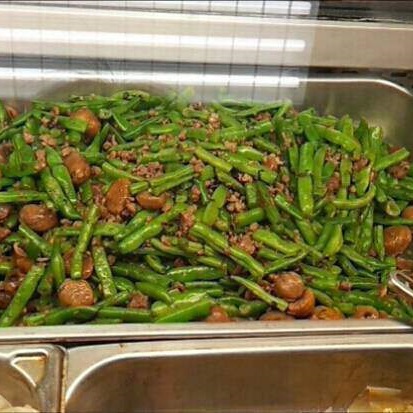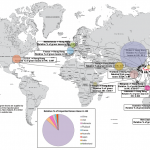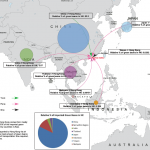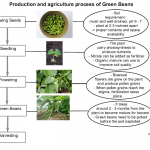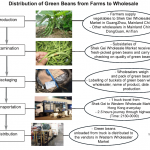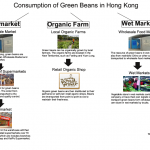Imported Green Beans in Hong Kong
Green bean is one of the categories of vegetables. Two of its variety, namely French Bean and Long Bean in various forms are highly accessible to citizens in Hong Kong. We could get cooked green beans in restaurants, fresh beans in the supermarket and wet market. Green bean is also available in canned form for longer preservation. Small amount of green beans are locally produced. Mainland China and the United State contribute to 86. 1 % of the imported green beans of Hong Kong. The remaining proportion of green beans is from
Indonesia, Thailand, France, Australia, Japan, India, Netherland, Kenya, Taiwan, New Zealand and Malaysia. Green beans in Hong Kong come from mostly the countries in Asia. In fact, 88. 25% of the imported green beans in Hong Kong are supplied by countries in Asia. Japan, Malaysia, Thailand, India and Indonesia supply green beans to Hong Kong via air mode of transportation. China, being the nearest supplier outside Hong Kong, send trucks which carries along the green beans together with other vegetables to travel through highways to reach Hong Kong. Meanwhile, Taiwan ships green beans into Hong Kong. We see that the cost involved in transportation of green beans.
Production
Green beans are grown in traditional farms and organic farms and there are special requirements about the soil quality and the environment. Green beans have to grow in soil that is moist, well-drained and has a pH at around 6 to 7. Excessive water and inappropriate pH can cause the plant to rot. Warm environment is another criterion for the healthy growth of the bean plant. The optimum temperature range is 1 5. 5 – 26. 5 degree Celsius. Extreme weather will af ect the germination of seeds and pod formation. I t is better to plant the beans at 2 to 3 inches apart to ensure enough nutrients and proper space for growth. After sowing, the seeds will germinate under favourable condition and then grow to seedlings. Nitrate can be added as fertilizer at this stage. When the plants grow larger, they can carry out photosynthesis and nitrogen fixation to meet their nutrients need so the amount of fertilizer use in planting green beans is very low. Organic manure can be added to improve the soil quality. Green beans are bisexual flowering plants. After pollination and fertilization, green beans are formed with pods. They are then harvested and are ready to sell to the market. I t usually takes 2 to 3 months for the plants to become mature. Although there is limited amount of fertilizer and pesticide use in planting green beans, there are still some impacts on the environment and health of people. They can pollute the soil, underground water and water sources. When the fertilizers are leaked to rivers and lakes, they can stimulate the growth of algae which in turns decrease the oxygen availability to aquatic lives. Also, workers that handle pesticides can have health problems, such as dizziness and vomiting.
Retail
Green beans are mainly available in markets, including wet markets and supermarkets. Examples of wet markets are 76 public markets managed by Food and Enviornemntal Hygiene Department, HKSAR and Chinese wet markets in 1 8 districts in Hong Kong. Example of supermarkets are Kai Po Food Supermarket, Wellcome etc. They are then purchased and prepared in dishes. Organic Farms: Organic farmlands serve vistors with fresh green beans orginated from organic farming methods. They are not transported to wholesale food markets but directly be sold at the farms or at organic retail shops in urban areas. Rooftop farming is also popular in the society. Citizens can harvest green beans at the roof from buildings participated in green rooftop program.
Distribution
Looking at the distribution process imported green beans in Hong Kong have gone through, specifically those supplied by Mainland China. Wholesale markets in Mainland China, such as ShekGei, An Tian and DongGuan, usually have subsidiaries to deal with farmers across the district. Upon production of the green beans, farmers send the freshly-picked green beans to subsidiaries of wholesale markets. The subsidiaries then perform checking on quality of green beans and eliminate the bad ones. Subsidiaries then send the qualified green beans to the wholesaler for weighing and packaging. Green beans are usually packed into plastic bags to ease the retail process. Few packets of green beans are then positioned into a bucket. Each bucket to be sent onto a truck which belongs to a logistic company will be labelled with a tag. Information on the name and address of subsidiary, name of product, date and batch of production of product could be obtained from the tag. Through interviewing a worker of a logistic company which carried vegetables from ShekGei to Hong Kong, we knew that green beans are not exported by ShekGei Wholesale Market to Hong Kong every day. Instead, when green beans are available for wholesale, they will be transported together with other vegetables under preserved condition to Hong Kong. The truck usually departs from ShekGei at nine thirty at night and arrive at the Western Wholesale Market of Hong Kong during midnight. I t will usually be a two and a half hour journey of driving, including undergoing the investigations by the immigration upon entering Hong Kong. Buckets of green beans will be unloaded from truck to be distributed to vendors who have already placed their order to ShekGei Wholesale Market.
Disposal
There are various kinds of waste produced in the food network of green beans. During the production process, chemical waste, such as excessive use of fertilizers and pesticides, is produced. This waste can be treated in the farms or at the chemical waste treatment centre and then sent to the landfills. There are also unsold and unconsumed beans in the farms as they may be destroyed by bad weather and pests, and not in good shape. This food waste is either converted to fertilizers using the composting facilities in the farms or disposed to the landfills. Before transporting to the wholesale market, the green beans will usually reach the packaging site. The excessive use of paper, plastics and Styrofoam in packaging produced waste. Some of the paper and plastics can be recycled and convert to useful substances while others are dumped to landfills. In the wholesale market, retailers and restaurants, food waste produced can be divided into rotten green beans and surplus green beans. Both types of food waste can be sent to the composting facilities of the government. With the advance technology there, food waste is converted into compost that can be applied to landscaping, fruit and vegetable production.
Moreover, the surplus green beans and cooked dishes in restaurants that are safe to eat can be collected by NGOs, such as Ever Green Association, and distributed to the needy in society. Beans that are not collected nor composted will be disposed to transfer stations and then sent to landfills. Last, for the household food waste, some of the housing facilities will collect food waste from household and have their own composting facilities while other people will dispose their waste to rubbish bins instead. Dumping food waste into landfills is diminishing the value of food as it can be used to help the needy in society and support local food production if they are managed properly. Also, it causes serious environmental impacts, including to contamination of groundwater, soil erosion, emission of methane and odour smell.
Ng Yee Ling
Pe Chun Hin
Siu Long Ying

